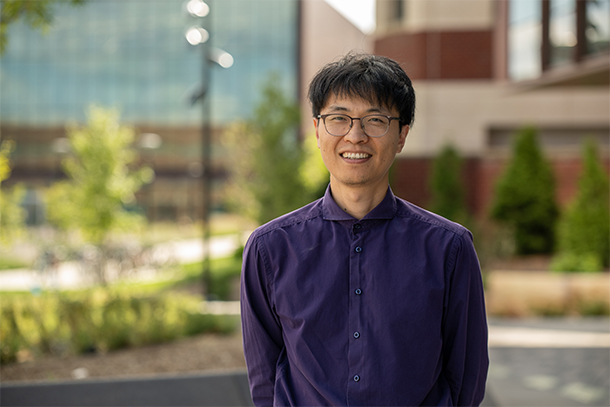
Yun Jing, professor of acoustics at Penn State, answered questions related to his new U.S. National Science Foundation grant on exploratory nonlinear acoustics. Credit: Kate Myers/Penn State.
Q&A: Yun Jing on acoustic holograms and vortex beams
NSF grant to support exploratory acoustics research at Penn State
Aug 28, 2024
By Mariah Lucas
UNIVERSITY PARK, Pa. — Acoustics research at Penn State has begun to sound like science fiction, with mentions of holograms, vortex beams and a remote whispering beam. Yun Jing, professor of acoustics and of biomedical engineering in the Penn State College of Engineering, recently received a three-year, $418,136 grant from the U.S. National Science Foundation to study nonlinear acoustic effects in wavefront shaping.
Jing discussed the proposed research, which he describes as a “theoretical and experimental playground,” in an interview with Penn State News.
Q: What is the difference between linear and nonlinear acoustics? How do nonlinear acoustics surpass limitations in traditional linear acoustics research?
Jing: In linear acoustics, sound waves behave linearly — what you put in is what you get out, just louder or quieter, but without any new sounds being created. For example, if you play a single note on a piano, the sound you hear is purely that note, with no additional frequencies.
Nonlinear acoustics, however, can create entirely new frequencies that were not present in the original sound. This happens when sound waves are so intense that they start interacting with each other in complex ways. For instance, we can use ultrasound waves — that are normally inaudible to humans — to generate new, audible sounds by combining them in a nonlinear way.
This ability to create new frequencies gives us a powerful new tool. With nonlinear acoustics, we can "tune" audible sounds using ultrasound, something that simply isn't possible with traditional linear acoustics. This opens up new possibilities in sound control and manipulation, allowing us to overcome the limitations of conventional acoustics.
Q: What are vortex beams, self-bending beams and acoustic holograms? What scientific advancements could be enabled by them?
Jing: Vortex beams, self-bending beams and acoustic holograms are fascinating developments in acoustics, originally explored within the context of linear acoustics.
Vortex beams, for instance, are a unique type of sound wave that have a swirling pattern as they travel through fluids, and have been proposed for high-speed underwater communication. Self-bending beams, such as Airy beams, have the unique ability to curve as they propagate, allowing them to navigate around obstacles without losing their shape. Acoustic holograms enable the creation of detailed and complex sound fields, similar to how optical holograms create three-dimensional visual images.
While these concepts have been well-studied in linear acoustics, their potential in nonlinear acoustics remains largely unexplored. Our grant focuses on investigating these advanced sound waves in nonlinear regimes, where entirely new behaviors can emerge. For example, in the U.S. audio industry, nonlinear acoustics could revolutionize how we manipulate and control audio sound, allowing for innovations such as creating highly focused and personal sound zones that were not possible before.
Q: What is the new phenomenon that your research group has coined the “remote whispering beam” and how will you study it in this grant?
Jing: The "remote whispering beam" is a novel acoustic phenomenon in nonlinear acoustics where sound is delivered to a specific location behind an obstacle without being heard along the path. We will study this by generating self-bending ultrasonic beams that converge to create an audible spot behind the obstruction. The research will involve both theoretical modeling and experimental validation to explore this intriguing effect and its potential applications in secure communication and sound field control.
Q: Could this grant bolster national security? If so, how?
Jing: Yes, this grant has the potential to significantly bolster national security, particularly in advancing communication systems for the U.S. Navy. One of the key applications of our research in nonlinear acoustics is improving underwater communication through the use of nonlinear vortex beams. These beams can carry information efficiently over long distances, even in challenging underwater environments, which is crucial for naval operations.
By exploring the nonlinear aspects of these acoustic waves, we can develop more secure and reliable communication channels that are less susceptible to interference and eavesdropping. This would enhance the Navy's ability to communicate discreetly and effectively in critical situations, thereby strengthening national security.
In addition to communication systems, the ability to control and manipulate sound in new ways could also lead to innovations in stealth technology and underwater surveillance, further contributing to the safety and security of our nation.
Q: How will this research impact education and outreach at Penn State?
Jing: We plan to integrate the findings into our curriculum at Penn State, particularly in courses on nonlinear and computational acoustics. Additionally, we will engage in outreach activities to inspire the next generation of engineers and scientists, particularly those from underrepresented groups, by demonstrating the fascinating possibilities of advanced acoustics research.

